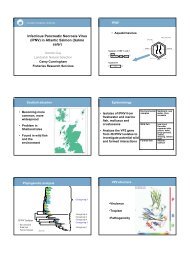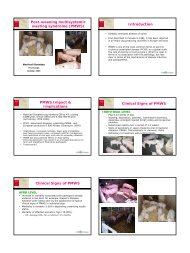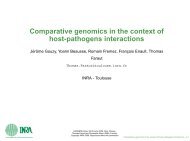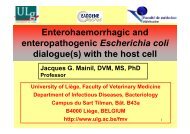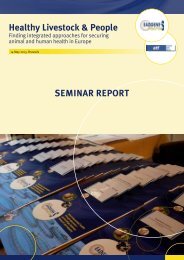Joan Lunney
Joan Lunney - eadgene
Joan Lunney - eadgene
Create successful ePaper yourself
Turn your PDF publications into a flip-book with our unique Google optimized e-Paper software.
Genomics of interaction of Salmonella with porcine lymph nodes and enterocytes<br />
<strong>Joan</strong> <strong>Lunney</strong> (APDL, BARC, ARS, USDA, Beltsville, MD)<br />
Genomics of interaction of Salmonella with<br />
porcine lymph nodes and enterocytes<br />
<strong>Joan</strong> <strong>Lunney</strong><br />
APDL, BARC, ARS, USDA, Beltsville, MD<br />
Thursday 7th June 2007<br />
E. coli and Salmonella workshop<br />
Utrecht, The Netherlands<br />
Transcriptional Response of Pigs to Salmonella<br />
infection: Comparison of responses to infection with<br />
Salmonella enterica serotype Typhimurium as that<br />
observed in S. Choleraesuis infection<br />
JJ Uthe 1,2 , SMD Bearson 2 , YF Wang 1 , L Qu 1 ,<br />
D Kuhar 3 , TJ Stabel 2 , SH Zhao 4 , OP Couture 1 ,<br />
D Nettleton 5 , JC Dekkers 1 , CK Tuggle 1 , JK <strong>Lunney</strong> 3<br />
1 Dept. of Animal Science, Iowa State University, Ames, IA USA<br />
2<br />
National Animal Disease Center, USDA-ARS, Ames, IA USA<br />
3<br />
Animal Parasitic Diseases Lab, USDA-ARS, Beltsville, MD USA<br />
4<br />
Lab of Molecular Biology and Animal Breeding, Huazhong<br />
Agricultural Univ., Wuhan, PR China<br />
5<br />
Dept. of Statistics, Iowa State University, Ames, IA<br />
Funding: USDA ARS funds and CSREES grants<br />
Research Goals<br />
General: Understand immune and genetic basis of swine infectious<br />
disease responses to pathogens<br />
Specific: Compare effects of Salmonella enterica serotypes<br />
Choleraesuis (SC) and Typhimurium (ST) on gene and protein<br />
expression in infected pig tissues and in monolayer cultures of<br />
porcine epithelial cells (IPEC J2 cells)<br />
Innate<br />
Immunity<br />
Targets:<br />
• Predict host protective responses to bacteria<br />
• Improve strategies for vaccination to prevent infection<br />
• Discover new targets for antibacterial agents for disease control<br />
• Identify differences in host responses between Salmonella<br />
pathogens<br />
Long term goal: Prevent bacterial persistence<br />
E. Thacker. The Pig Journal 54: 55 (2004) www.thepigsite.com/FeaturedArticle/Default.asp?Display=1284<br />
Differentiation Swine Immune Gene<br />
Expression: T helper 1 (Th1) versus Th2<br />
Definition of Th1 (Toxoplasma gondii) and Th2<br />
(Ascaris suum) immune responses in swine.<br />
Use of real-time RT-PCR technology to measure targeted gene<br />
expression at multiple tissues sites<br />
Link between Innate and Adaptive Immune Systems<br />
IFNA?<br />
?<br />
Dawson HD, Beshah E, Nishi S, Solano-Aguilar G, Morimoto M,<br />
Zhao A, Madden KB, Ledbetter TK, Dubey JP, Shea-Donohue T,<br />
<strong>Lunney</strong> JK, Urban JF Jr. 2005. Infection and Immunity 73: 1116.<br />
PIN (Porcine Immunology and Nutrition) database<br />
http://www.ars.usda.gov/Services/docs.htm?docid=6065<br />
Curated by Harry Dawson, NRFL, BHNRC, BARC<br />
EADGENE E. coli and Salmonellla Workshop, 7 June 2007, Utrecht, NL<br />
This presentation is the property of <strong>Joan</strong> <strong>Lunney</strong> of the USDA.<br />
This presentation should not be reproduced without the author's permission. 1/7
Genomics of interaction of Salmonella with porcine lymph nodes and enterocytes<br />
<strong>Joan</strong> <strong>Lunney</strong> (APDL, BARC, ARS, USDA, Beltsville, MD)<br />
Toll-Like Receptor and NFκB Pathways [Tuggle]<br />
www.biocarta.com<br />
Swine Salmonella infections<br />
Comparative gene expression response studies<br />
Salmonella enterica serovar Typhimurium [S. Typhimurium, ST]<br />
pig and human pathogen - broad host range<br />
clinical disease - usually enterocolitis<br />
food safety issue<br />
Salmonella enterica serovar Choleraesuis [S. Choleraesuis, SC]<br />
pig pathogen - narrow host range<br />
clinical disease - septicemia, enterocolitis, pneumonia and/or<br />
hepatitis<br />
References:<br />
Zhao et al, Mamm Genome. 17: 777, 2006<br />
Uthe et al, Vet Micro 114: 60, 2006; Molec Immunol 44: 2900, 2007<br />
Wang et al, Genomics In Press, 2007 (ST); In preparation (SC).<br />
Tuggle et al, next talk<br />
Swine Gene Arrays<br />
swine long oligo microarrays<br />
• NRSP8-Qiagen 12,500 probes, 2003 design<br />
Zhao et al. Genomics. 86: 618, 2005;<br />
Mamm Genome 17: 777, 2006<br />
• updated NRSP8-Illumina 20,000 probes, 2006 design<br />
Testing underway<br />
Affymetrix arrays<br />
• 20,000 probes, 2004<br />
Wang et al. Genomics. 2007 May 11 epub<br />
Arrays enable broad tissue specific gene expression analyses;<br />
data affirmed with real time PCR analyses and protein<br />
assays [when assay and relevant sample are available.]<br />
Quantitative bacteriology of the ileocecal lymph nodes<br />
in swine inoculated with Salmonella<br />
[Most probable number method used for Salmonella cfu;<br />
A<br />
cfu/g ICLN<br />
1000000<br />
100000<br />
10000<br />
1000<br />
100<br />
10<br />
1<br />
# statistically different at p
Genomics of interaction of Salmonella with porcine lymph nodes and enterocytes<br />
<strong>Joan</strong> <strong>Lunney</strong> (APDL, BARC, ARS, USDA, Beltsville, MD)<br />
Gene expression profiling in Salmonella serovar Choleraesuis<br />
infected lung using a long oligonucleotide Qiagen-NRSP-8 swine array<br />
Real-time<br />
immune gene<br />
expression in<br />
S. Choleraesuis<br />
infected porcine<br />
lung<br />
Function classification of increased genes<br />
at 48 hour infection with p values < 0.001<br />
Use real time assays to<br />
target sets of genes<br />
involved in pathways<br />
identified with arrays<br />
and with anti-bacterial<br />
immune responses.<br />
Zhao et al. 2006. Mammalian Genome. In Press.<br />
Summary of immune gene expression in<br />
S. Choleraesuis infected porcine lung<br />
• qRT-PCR of 61 differentially expressed (DE) genes confirmed<br />
the microarray results. [23/33 DE genes confirmed]<br />
• Two transglutaminase family genes (TGM1 and TGM3),<br />
associated with apoptosis, showed dramatic increases post<br />
inoculation; affirmed by qRT-PCR for other genes, indicating<br />
induction of apoptotic pathways<br />
• Predominant T helper 1 (Th1)-type immune response, with<br />
interferon gamma (IFNG) significantly increased at 48 hpi<br />
along with genes induced by IFNs (GBP1, GBP2, C1S, C1R,<br />
MHC2TA, PSMB8, TAP1, TAP2) in porcine lung infection.<br />
• Limited changes in innate and Th2 associated genes and<br />
general immune associated genes.<br />
Zhao et al. Mammalian Genome. 17: 777, 2006<br />
www.biocarta.com<br />
Swine Salmonella infections –<br />
comparative response studies<br />
Infections:<br />
Salmonella enterica serovar Typhimurium (ST)<br />
S. Typhimurium; pig and human pathogen; clinical<br />
disease and food safety issue<br />
S. Choleraesuis (SC)<br />
pig pathogen; clinical disease<br />
Animals: 3 pigs/necropsy at 8, 24, 48 hr pi; 7 and 21 dpi<br />
Tissues collected: lung, mesenteric lymph node (MLN),<br />
liver, spleen<br />
Analyses: suppression subtractive hybridization (SSH)<br />
http://users.path.ox.ac.uk/~ciu/FionaPowrieGroup1.htm<br />
EADGENE E. coli and Salmonellla Workshop, 7 June 2007, Utrecht, NL<br />
This presentation is the property of <strong>Joan</strong> <strong>Lunney</strong> of the USDA.<br />
This presentation should not be reproduced without the author's permission. 3/7
#<br />
#<br />
#<br />
# #<br />
#<br />
#<br />
#<br />
#<br />
#<br />
Genomics of interaction of Salmonella with porcine lymph nodes and enterocytes<br />
<strong>Joan</strong> <strong>Lunney</strong> (APDL, BARC, ARS, USDA, Beltsville, MD)<br />
Differentially expressed genes identified by SSH in MLN<br />
from swine experimentally inoculated with S. Choleraesuis<br />
Uthe et al. Vet Micro<br />
114: 60, 2006<br />
MLN Differential gene expression in response<br />
to S. Choleraesuis and S. Typhimurium<br />
Suppression subtractive hybridization (SSH) identified<br />
7 genes as up-regulated in MLN at 24 hpi in S. Choleraesuisinfected<br />
pigs (ARPC2, CCT7, HSPH1, LCP1, PTMA, SDCBP,<br />
VCP)<br />
3 genes in S. Typhimurium-infected pigs<br />
(CD47/IAP, CXCL10, SCARB2)<br />
Experimental design: These genes were then targeted for<br />
comparative analyses of gene expression on MLN RNA<br />
collected at 8, 24, 48 hr pi; and at 7 and 21 dpi<br />
Uthe et al., Molec. Immunol. 44: 2900, 2007<br />
Differential expression of<br />
the SSH-enriched genes<br />
from the Salmonellainfected<br />
swine using realtime<br />
PCR.<br />
The results are expressed as<br />
the fold change in gene<br />
expression in the<br />
S. Choleraesuis- (solid) or<br />
S. Typhimurium- (open)<br />
infected pigs compared to the<br />
non-infected controls.<br />
Statistical differences (* = P
Genomics of interaction of Salmonella with porcine lymph nodes and enterocytes<br />
<strong>Joan</strong> <strong>Lunney</strong> (APDL, BARC, ARS, USDA, Beltsville, MD)<br />
Conclusions: Salmonella immunity studies<br />
For both pathogens, immune response initiated within 24 hr;<br />
intensity, nature and persistence differed between pathogens.<br />
S. Choleraesuis infection stimulated classic innate and<br />
inflammatory response lasting to 7, even 21, dpi<br />
S. Typhimurium infection stimulated a mild and transient immune<br />
response, potentially evading (suppressing?) pig’s immune<br />
system. This may aid progression into persistent infection, and<br />
carrier state.<br />
Immune gene expression correlates well with the clinical signs<br />
(fever) in infected animals, indicating the expression profiles will<br />
reveal pathways important to disease resistance and prevention<br />
Gene expression kinetics may reveal genes responsible for the<br />
variation in disease progression observed in swine infected with<br />
S. Typhimurium compared to S. Choleraesuis.<br />
Uthe et al., Molec. Immunol. 44: 2900, 2007<br />
Salmonella response studies<br />
Compare early response [0, 8, 24, 48 hpi] to both<br />
pathogens, S. Typhimurium (ST) and S. Choleraesuis<br />
(SC) infections<br />
Affymetrix swine array [23,256 transcripts from 20,201<br />
genes]<br />
16,229 and 16,046 probe sets (~70 %) showed MLN<br />
expression during the ST infection and the SC<br />
infection, respectively<br />
848 and 1,949 genes showed differential expression<br />
across different times after ST and SC inoculation or<br />
when compared to non-inoculated controls.<br />
Wang, Qu, et al Genomics 2007 epub; in preparation<br />
Gene Ontology (GO) categorization of porcine ST infected MLN transcriptome<br />
Transcriptional profile of genes<br />
selected as cell-type markers or<br />
immune response pathway genes<br />
shows no evidence that<br />
transcriptional changes are due to<br />
cell migration into ST infected MLN.<br />
The fold change were calculated using<br />
Genecluster. Statistical differences (P
Genomics of interaction of Salmonella with porcine lymph nodes and enterocytes<br />
<strong>Joan</strong> <strong>Lunney</strong> (APDL, BARC, ARS, USDA, Beltsville, MD)<br />
Early Take Home Lessons from<br />
Gene Expression Studies<br />
• Developed improved understanding of immune<br />
pathways (T helper 1, apoptosis, NFκB) regulating<br />
anti-Salmonella responses<br />
• Verified complexity of host specific factors<br />
• Identified potential genes which encode genomic<br />
controls<br />
• Highlighted target responses and pathways for new<br />
vaccination and drug treatment strategies<br />
• Test use of cell lines (IPEC J2) for in vitro studies<br />
Combine 24h/0, 48h/0, 24h/8h, 48h/24h up regulated genes in SC.<br />
• Pathogen specific patterns [dependence on pathogen<br />
isolate, local tissue, cellular interactions, time after<br />
infection] could be enhanced with microbial arrays<br />
Salmonella-cell culture invasion assay using IPEC-J2 cells<br />
Question: Can selected cell cultures reveal bacterial infection<br />
effects?<br />
Model: Porcine intestinal epithelial cells (IPEC-J2) grown in<br />
transwell cultures are enterocyte-like with microvilli, tight<br />
junctions and glycocalyx-bound mucin. Proven to be a relevant<br />
in vitro model system for porcine intestinal pathogen-host cell<br />
interactions; can be infected with Salmonella<br />
(Schierack et al. Histochem Cell Biol. 125: 293, 2006.)<br />
Samples collected:<br />
Cells for RNA by adding Trizol, freezing at –80°C<br />
and shipping to BARC for gene expression assays<br />
Supernatant from the Transwell insert and bottom of<br />
the well for protein expression assays. [not yet tested]<br />
Salmonella invasion analysis: Triton x-100 to Transwell; plate lysate dilutions<br />
Salmonella-cell culture invasion assay using IPEC-J2 cells<br />
I. Preparation of polarized IPEC-J2 cells:<br />
• Polarize IPEC-J2 cells in 6 well plates-permeable supports<br />
(Transwell polyester membranes with 0.4 μm pore size).<br />
• Seed IPEC-J2 cells at density 3.5-2.5x105 cells/well.<br />
• Polarize cells for 7-9 days.<br />
II. Preparation of bacterial inoculum:<br />
• Start bacterial cultures from a single colony. Grow overnight.<br />
III. IPEC-J2 invasion-gene expression experiment:<br />
• Prewash IPEC-J2 cells; Add inoculum at MOI=300; control<br />
medium only.<br />
• At 2 hr after inoculation, add Gentamicin bacteria killing media<br />
• Incubate cells at 37°C, 5% CO2 for 2 hr, 4 hr and 8 hr<br />
Effect of S. Choleraesuis (SC) and S. Typhimurium<br />
(ST) infection on gene expression in monolayer<br />
cultures of porcine IPEC J2 epithelial cells<br />
• In vivo earlier, but limited, immune response to<br />
S. Typhimurium infection<br />
• In vitro earlier, but higher, up regulation of chemokines,<br />
innate cytokines and TLRs with S. Typhimurium infection<br />
• Similar kinetics of IL8 and CCL20, not TNF, RNA upregulation<br />
in response to SC and ST infections at lower MOI<br />
(Skjolaas Vet Im Immunopathol. 115:299, 2007, 10 8 ST/well).<br />
• Broader array of chemokines (CCL2, CCL3) and apoptosis<br />
(TGM3) markers shown to be up-regulated.<br />
• NFkB targets upregulated with ST infections.<br />
Note: gene not protein expression results. Protein expression<br />
planned; certain reagents not available.<br />
Unpublished data<br />
EADGENE E. coli and Salmonellla Workshop, 7 June 2007, Utrecht, NL<br />
This presentation is the property of <strong>Joan</strong> <strong>Lunney</strong> of the USDA.<br />
This presentation should not be reproduced without the author's permission. 6/7
Genomics of interaction of Salmonella with porcine lymph nodes and enterocytes<br />
<strong>Joan</strong> <strong>Lunney</strong> (APDL, BARC, ARS, USDA, Beltsville, MD)<br />
US Veterinary Immune Reagents Network<br />
Plan to begin to systematically address the immunological reagent<br />
gap for the veterinary immunology research community<br />
Goal: express immune proteins (cytokines, chemokines, acute<br />
phase reactants) and produce specific monoclonal antibodies to<br />
immune markers [T cell receptors (TCRs), toll-like receptors<br />
(TLRs), cell surface differentiation (CD) markers]<br />
Develop panel of markers for immune proteomic studies<br />
Coordination + mAb Production: Baldwin, Univ. MA<br />
Protein Expression: LaBresh, Kingfisher Biotech.<br />
Ig and TCR Expression: Wagner, Cornell Univ.<br />
Species: Ruminants, concentrating on cattle - Baldwin, Univ. MA<br />
Swine - <strong>Lunney</strong>, ARS BARC<br />
Poultry, primarily chickens – Lillehoj, ARS BARC<br />
Horses – Horohov, Univ. KY; Wagner, Cornell Univ.<br />
Aquaculture species: channel catfish – Miller, MSU; trout – Hansen, USGS<br />
USDA CSREES Toolkit Network grant 2006-2010<br />
Swine Toolkit<br />
Priorities<br />
• TCRα,β reagents<br />
• TLRs<br />
• chemokines<br />
• CD45RO<br />
• Cytokines, e.g., IFNA – more sensitive reagents<br />
• IgGs – note separate NPB grant with J Butler, U Iowa<br />
Goals:<br />
• Produce large scale quantities of bioactive protein needed with accurate<br />
measure of bioactivity;<br />
• Provide full length cDNAs<br />
• Produce mAb useful for cytokine and chemokine protein quantitation using<br />
• ELISAs and ELISpot assays as well as alternate formats, e.g., Luminex,<br />
intracellular and fixed tissue staining<br />
• Repository<br />
What do you need? Send me suggestions<br />
email: jlunney@anri.barc.usda.gov<br />
Colleagues<br />
Nishi<br />
<strong>Lunney</strong> Dawson<br />
Thanks!<br />
Nishi Samon Royaee <strong>Lunney</strong> Kuhar<br />
BARC<br />
Wang Tuggle Couture<br />
Iowa State Univ.<br />
Uthe Bearson<br />
NADC<br />
email: jlunney@anri.barc.usda.gov<br />
soon to be: joan.lunney@ars.usda.gov<br />
websites: www.anri.barc.usda.gov/pbel/sy_lunney.asp<br />
www.ars.usda.gov/pandp/people/people.htm?personid=3471<br />
EADGENE E. coli and Salmonellla Workshop, 7 June 2007, Utrecht, NL<br />
This presentation is the property of <strong>Joan</strong> <strong>Lunney</strong> of the USDA.<br />
This presentation should not be reproduced without the author's permission. 7/7



